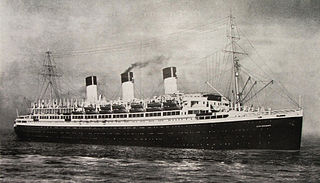SS Cap Arcona (1927)
|
Cap Arcona in 1927
|
|
| History | |
|---|---|
|
|
|
| Name: | Cap Arcona |
| Namesake: | Cape Arkona |
| Operator: | Hamburg Südamerikanische Dampfschifffahrts-Gesellschaft |
| Route: | Hamburg – Buenos Aires |
| Builder: | Blohm & Voss, Hamburg |
| Yard number: | 476 |
| Laid down: | 21 July 1926 |
| Launched: | 14 May 1927 |
| Maiden voyage: | 29 October 1927 |
| Homeport: | Hamburg |
| Identification: |
|
| Nickname(s): | Queen of the South Atlantic "The Floating Palace" |
| Fate: | Requisitioned for the Kriegsmarine in 1940 |
|
|
|
| Name: | Cap Arcona |
| Operator: | Kriegsmarine |
| Acquired: | 29 November 1940 |
| Out of service: | 1940–14 April 1945 |
| Fate: | Sunk by air attack on 3 May 1945. Wreck dismantled in 1949. |
| General characteristics | |
| Class and type: | ocean liner |
| Tonnage: | |
| Length: | 205.90 m (675 ft 6 in) overall |
| Beam: | 25.78 m (84 ft 7 in) |
| Draught: | 8.67 m (28 ft 5 in) |
| Depth: | 14.30 m (46 ft 11 in) |
| Decks: | 5 |
| Installed power: | 23,672 shp (17,652 kW) |
| Propulsion: | eight steam turbines, two propellers |
| Speed: | Service: 20 knots (37 km/h; 23 mph) |
| Range: | 11,110 nmi (20,580 km; 12,790 mi) at 20 knots (37 km/h; 23 mph) |
| Boats & landing craft carried: |
26 lifeboats |
| Capacity: |
|
| Crew: | 475 |
| Sensors and processing systems: |
|
Cap Arcona, named after Cape Arkona on the island of Rügen, was a large German ocean liner built for the Hamburg Südamerikanische Dampfschifffahrts-Gesellschaft ("Hamburg-South America Line"). She carried passengers and cargo between Germany and the east coast of South America, and in her time was the largest and quickest ship on the route.
In 1940 the Kriegsmarine requisitioned her as an accommodation ship. In 1942 she served as the set for the German propaganda feature film Titanic. In 1945 she evacuated almost 26,000 German soldiers and civilians from East Prussia before the advance of the Red Army.
Cap Arcona's final use was as a prison ship. In May 1945 she was heavily laden with prisoners from Nazi concentration camps when the Royal Air Force sank her, killing about 5,000 people; with more than 2,000 further casualties in the sinkings of the accompanying vessels of the prison fleet; SS Deutschland and Thielbek. This was one of the biggest single-incident maritime losses of life in the Second World War.
Blohm & Voss in Hamburg built Cap Arcona, launching and completing her in 1927. She was 27,561 GRT, 205.90 m (675 ft 6 in) overall and had a beam of 25.78 m (84 ft 7 in).
She was driven by eight steam turbines, single-reduction geared to two propeller shafts. She had three funnels, and her passenger comforts included a full-size tennis court abaft her third funnel. The ship had at least 26 lifeboats, most of which were mounted in two tiers (see image).
...
Wikipedia

